Abstract
The article is devoted to the study of selenium (VI) reduction processes in sulfuric acid solutions when titanium electrodes are polarized by alternating current of industrial frequency (50 Hz). It was found that selenate ion reduction occurs on the surface of titanium electrodes in the cathode half-cycle of alternating current (practically at the cathode) by reaction: + 6e + 8H+ → Se + 4H2O. In addition, the recovery is carried out by titanium (III) ions: 6Ti3+ + 8H+ → Se + 6Ti4+ + 4H2O. It has been established that titanium (III) ions are products of dissolution of titanium during polarization by alternating current, so they can be formed by reaction: 2Ti + 6H+ → 2Ti3+ + 3H2. Reduction in selenate ions during polarization by alternating current can also occur due to the cementation reaction with titanium: 3Ti + 2 + 16H+ → 2Se + 8H2O + 3Ti4+. It was shown for the first time that the selenate ion is reduced to form a dispersed selenium powder with a high current efficiency. Depending on the conditions, both amorphous and crystalline selenium modifications are produced.
1. Introduction
Selenium is a typical representative of the group of rare trace elements. Selenium and its compounds have semiconductor properties and are widely used in the electronics industry [1,2]. This element does not have its own deposits, it is an accompanying element and is mined during the processing of ores and concentrates of heavy non-ferrous metals. One of the main sources of selenium, tellurium, as well as gold and silver is the bottom sludge formed during the electrorefining of non-ferrous metals. World practice has accumulated extensive experience in the processing of selenium-containing sludge [3,4,5,6,7].
Modern methods of selenium extraction from the composition of sludge are based on their oxidation and transformation into compounds that are highly soluble in aqueous solutions of acids and alkalis.
In industrial practice, thermal oxidation methods are generally accepted [6]. In this case, selenium from the composition of the sludge passes into water-soluble compounds in the form of selenite and selenate ions. Selenite ions are easily reduced by chemical reducing agents, as well as by cathodic polarization. Selenate ions are very difficult to recover, i.e., they are not reduced at room temperature by chemical reagents and are not reduced at the cathode during electrolysis, in this regard, difficulties arise in extracting selenium from sludge.
In recent years, methods of electrochemical anodic leaching of selenium-containing sludge have been developed [8,9,10]. However, as the results of the research show, in this case selenium also passes into solution in the form of selenate ions. Consequently, it can be said that solutions in which selenium is present in the form of selenate ions are not processed, selenium is practically not extracted from them, i.e., a valuable element is irretrievably lost.
Well-known literature sources [4,5] indicate that selenium (VI) ions are reduced in alkaline solutions only at temperatures above 200 °C and high pressures only by strong reducing agents: hydrogen, sulfides and elemental sulfur or organic reagents. It is believed that at such high temperatures, the selenate ion decomposes to form selenite ions.
In acidic solutions, selenate ions are reduced in concentrated hydrochloric acid solutions by boiling [4,11] only to a tetravalent state:
The reduction in selenium by Reaction (2) proceeds under very harsh conditions (high temperature, concentrated solutions). In addition, only selenium (IV) ions are produced in this reaction. Further, to obtain elemental selenium, it is necessary to carry out the second stage of reduction using the above reducing agents, for example, sulfur dioxide:
The process of isolation of elemental selenium is a two-stage process and is difficult to carry out. During the Reactions (2) and (3), the working conditions deteriorate as much as possible. In addition, chemical methods carried out in both alkaline and acidic medium appear to be ineffective from a technological point of view.
According to [11], many highly charged anions of the XO4n− type are characterized by electrochemical inertia. The selenate ion has a similar property, the inertia of which is apparently explained by the tetrahedral structure of the anion, in which the selenium atom is surrounded on four sides by oxygen atoms, and also by the fact that the anion, having a negative charge, is repelled from the negatively charged surface of the cathode, as a result of which kinetic difficulties arise.
All existing methods of selenium isolation from selenium-containing solutions are associated with many difficulties. In this regard, a number of our studies were aimed at finding new methods for the reduction in selenate ions in order to use them to isolate selenium in elemental form.
In [12], the results of studies are presented, which show that in the presence of variable valence cations, the reduction in selenate ions becomes possible. It has been established that in a sulfuric acid solution containing selenate ions and tetravalent titanium ions, the latter are reduced to the trivalent state at the cathode:
Titanium (III) ions formed by Reaction (4) reduce selenate ions in the near-cathode space. In this case, elemental selenium and titanium (IV) ions are produced:
As a result of the Reaction (5), titanium (IV) ions are regenerated, which are reduced again at the cathode with the production of titanium (III) ions. In subsequent moments, titanium (III) ions again reduce selenate ions. Thus, the whole process is repeated cyclically. Titanium (IV) ions are not consumed in the process, they cyclically participate in the reduction reaction. In this regard, the process can be called catalytic. In this regard, the process can be called catalytic. The experimental results show that as a result of electrolysis carried out at room temperature, the current efficiency of reduction in selenate ions to elemental selenium reaches 90%.
Cathodic reduction in Se (VI) ions from hydrochloric acid solutions can be carried out in the presence of the Cu(I)-Cu(II) redox system. In a chloride medium, copper (II) ions are reduced in stages [13]. In the first stage (Reaction (6)), copper (1) ions are produced.
The second stage proceeds slowly (Reaction (7)).
Copper (I) ions reduce ions in the near-cathode space, selenium is produced in the elemental form:
The results of electrolysis show that the current efficiency of the production of elemental selenium exceeds 90. We note that the same results were obtained when two copper electrodes were polarized by alternating current in hydrochloric acid solutions. However, similar reactions in sulfuric acid solution do not occur during electrolysis. In this regard, we have sought the possibility of reducing selenate ions from sulfuric acid solutions by polarization with industrial alternating current.
Preliminary studies have shown that when two titanium electrodes are polarized by alternating current in a sulfuric acid solution at a temperature of 25 °C, selenium (VI) is reduced to elemental powdered selenium.
In this regard, the purpose of our work was to study the influence of various parameters (current density, acid concentration and initial selenium (VI) concentration, temperature and frequency of alternating current) on the reduction process of hexavalent selenium on titanium electrodes during polarization by industrial alternating current in sulfuric acid solutions.
2. Experimental
Experiments on the processes of selenium reduction were carried out by electrolysis under the action of alternating current of industrial frequency (50 Hz) in a thermostated electrolyzer with two titanium electrodes of the VT-I-0 brand, the surface area of each electrode was 10 cm2. The interelectrode spaces were not separated, the solution was stirred with a magnetic stirrer. The AC power was regulated by a laboratory autotransformer. During electrolysis, selenium powder is produced on the surface of the titanium electrode. At the end of the experiment, the solution was filtered and the filtrate was analyzed for the residual amount of selenium (VI) ions. We note that selenate ions were preliminarily reduced by boiling in concentrated hydrochloric acid to selenite ions, which were then determined by the volumetric iodometric method [14]. At the same time, the mass of the resulting powder dispersion of elemental selenium was determined.
The main criterion for evaluating the results was the current efficiency of selenium powder production. In this case, it was assumed that at each titanium electrode in each cathode half-cycle of alternating current, the selenate ion is reduced to produce elemental selenium in the form of a powder.
3. Results and Discussion
Figure 1 and Figure 2 show the dependence of the current efficiency (CE) of the reduction in selenate ions with the production of selenium powders on the current density on titanium electrodes and the concentration of sulfuric acid. The current efficiency decreases with an increase in current density, and on the contrary, current efficiency increases with an increase in acid concentration. It should be noted that at a current density equal to zero, i.e., in the absence of polarization, the current efficiency value is zero, since titanium is always covered with an oxide film and does not undergo an oxidation reaction. This indicates that the reduction in selenate ions proceeds only when titanium electrodes are polarized by alternating current.
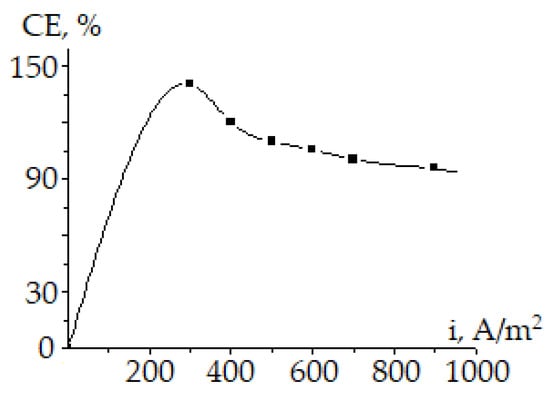
Figure 1.
Influence of current density on titanium electrodes on the current output of selenium powders formation: H2SO4 = 100 g/L; = 15 g/L; t = 20 °C.
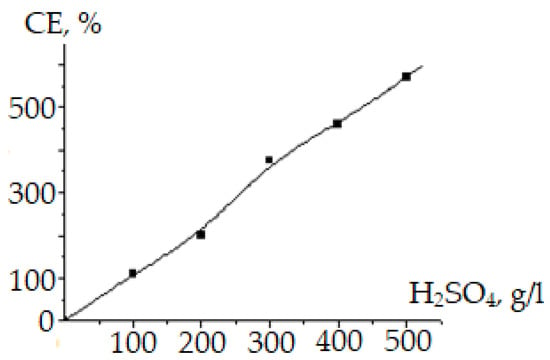
Figure 2.
Dependence of selenate ion reduction current output on the concentration of sulfuric acid: i = 500 A/m2; = 15 g/L; t = 20 °C.
The decrease in the current efficiency of selenium (VI) reduction with an increase in current density can presumably be explained by shielding the surface of titanium electrodes with powdered elemental selenium, which is a dielectric. In addition, the increase in current efficiency with an increase in the concentration of sulfuric acid is explained by the intensification of the dissolution of titanium, as a metal with a negative potential, and, accordingly, the formation of trivalent titanium cations, which are strong reducing agents.
The obtained experimental data indicate that when the titanium electrodes are polarized by an alternating current with a frequency of 50 Hz, selenium (VI) is reduced with an apparent high current efficiency. In this case, selenate ions are reduced to produce ultrafine selenium powders. As can be seen from the photograph (Figure 3), ultrafine selenium powders are produced with spherical particles having dimensions of no more than 1.0 μm.

Figure 3.
Micrographs of selenium powders obtained at different magnifications.
Apparently, the reduction in selenate ions in the cathode half-cycle (practically at the cathode) in this case can be explained by the negative value of the zero-charge potential on the titanium electrode (Ezcp = −0.7 V) and the effect of changing the direction of the high-frequency alternating current. It is believed that during polarization of titanium electrodes with an alternating current of a certain frequency, deformation or partial destruction of the structure of the selenate ion occurs, and this leads to its reduction in each cathode half-cycle of alternating current by the reaction:
As shown from Figure 1 and Figure 2, the apparent current efficiency exceeds 100%. This suggests that the reduction in selenium (VI) also occurs during its direct cementation with the electrode material—titanium (as a negative metal). In addition, as our previous studies have shown [12], when titanium is polarized by industrial alternating current in sulfuric acid solutions, a very thin oxide film present on the electrode surface is reduced in the cathode half-cycle, and then titanium, as a metal having a negative potential (E = −l.21 V) [15], interacts with hydrogen ions and dissolves to form trivalent ions:
2Ti + 6H+ → 2Ti3+ + 3H2
Thus, selenium (VI) ions can be reduced on the cathode surface by Reaction (9) with titanium (III) ions formed by Reaction (10), i.e., the selenate ion is reduced due to the Reaction (11) of titanium cementation and chemical Reaction (12):
The direct participation of titanium and its dissolution products (i.e., trivalent titanium ions) according to Reactions (3) and (4) is evidenced by a noticeable decrease in the mass of the titanium electrode during electrolysis (Figure 4):
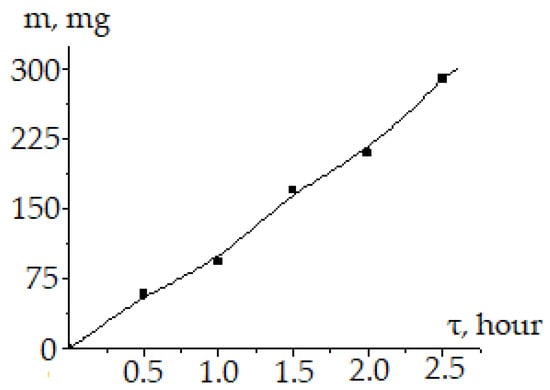
Figure 4.
The change in the mass of titanium electrodes during the selenium (VI) reduction on the duration of electrolysis: i = 500 A/m2; = 15.0 g/L; Se(VI) = 6.0 g/L; t = 20 °C.
We have shown previously [12] that titanium electrodes dissolve in a sulfuric acid solution to form trivalent titanium ions during polarization by alternating current, the dissolution current efficiency depends on the current density on the electrodes and on the concentration of sulfuric acid.
A regular increase in the current efficiency of selenium (VI) reduction with the production of selenium powders is observed with an increase in the initial concentration of selenate ions (Figure 5) and with an increase in the temperature of the solution (Figure 6).
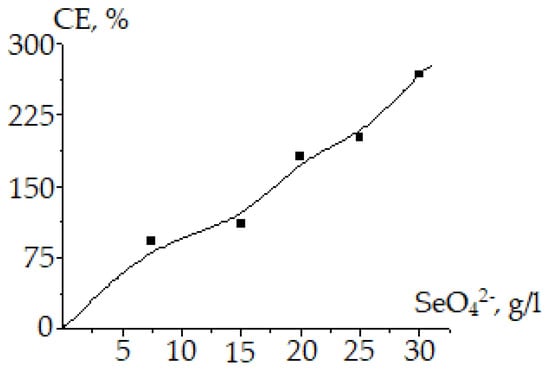
Figure 5.
Influence of the initial concentration of selenate ions on the current efficiency of selenium powders production: H2SO4 = 100 g/L; i = 500 A/m2; τ = 0.5 h; t = 20 °C.
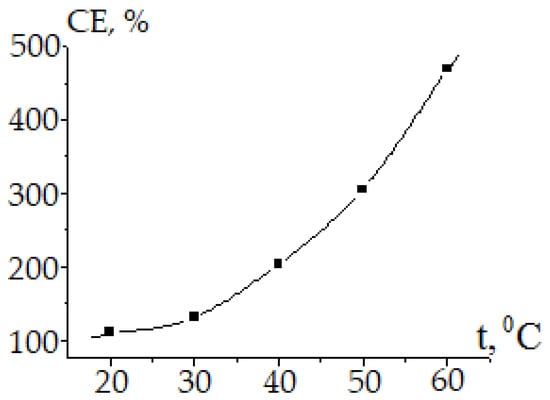
Figure 6.
The influence of the electrolyte temperature on the current efficiency of selenium powders production: H2SO4 = 100 g/L; = 15.0 g/L; i = 500 A/m2; τ = 0.5 h.
At temperatures close to room temperature, red amorphous selenium is produced, and if experiments are carried out at temperatures above 50 °C, black crystalline hexagonal powdered selenium is produced. The activation energy of the selenium (VI) reduction process, calculated according to the Arrhenius dependence, is 53.69 kJ/moL, which indicates that the process proceeds in a kinetic mode.
With an increase in the duration of electrolysis, the current efficiency naturally decreases. As can be seen from Figure 7, a change in the current frequency in the range of 20–500 Hz significantly affects the current efficiency of selenium recovery. This suggests a change in the structure of selenate ions during alternating current polarization.
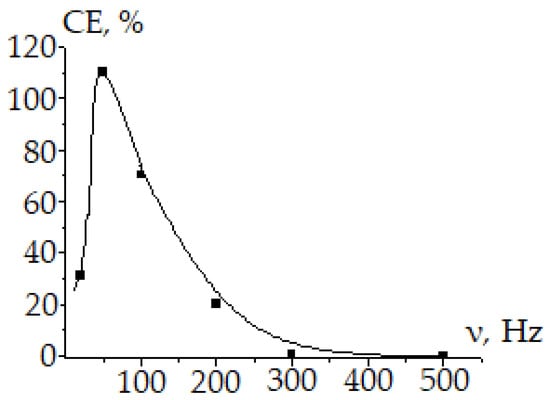
Figure 7.
Influence of the alternating current frequency on the current efficiency of selenate ions recovery: H2SO4 = 100 g/L; i = 500 A/m2; = 15.0 g/L; t = 20 °C.
As the research results show, the maximum value of the current efficiency is reached in the frequency range of 50–80 Hz. At a current frequency above 300 Hz, selenium (VI) recovery practically does not occur.
Thus, on the basis of our research, we have shown for the first time the possibility of reducing selenium (VI) with the production of elemental selenium in sulfuric acid solutions during the polarization of titanium electrodes by industrial alternating current. It has been established that the reduction in selenate ions occurs in the cathode half-cycle of alternating current, as well as directly by cementation with titanium, which is a negative metal and ions of trivalent titanium–products of dissolution of titanium electrodes. It is shown for the first time that the selenate ion is reduced to obtain a dispersed selenium powder with a high current efficiency. Depending on the conditions, both amorphous and crystalline modifications of selenium are produced.
The authors of [16,17,18] provide data on the methods of obtaining, important characteristics and various aspects of the use of selenium. For example, they claim that selenium nanomaterials are used in signal transmission devices, photographic exposure meters, and rectifiers. Selenium in powder form is used as a component in polymers. It is especially valuable that selenium supplements impart antioxidant properties to living organisms.
The role of selenium in living organisms is described in a review [19], which notes that small concentrations of selenium are used in medicine and as a food additive. The authors note that in some countries there are diseases associated with selenium deficiency. In addition, selenium is used in the production of glass and ceramics; in metallurgy, it is added to alloys as an alloying component. Selenium is also needed in optics and in electricity. In agriculture, it is used as an essential micronutrient. They even note the use of selenium in organic chemistry, in the manufacture of pigments, rubber, and lubricants.
In modern times, it is proposed to use selenium powder as a reducing agent in the production of graphene. In recent years, the demand for selenium in manganese, glass and other industries in China has increased.
4. Conclusions
Thus, we believe that the method and research results proposed in this paper are of considerable practical value. It should be noted that currently the industry is trying to carry out processes as much as possible so that hexavalent selenium, i.e., selenate ions, is not formed. Solutions containing selenate ions are thrown away, they are not processed, selenium is practically not extracted from them, since there are no acceptable methods. In this regard, the results of our research can be used to extract elemental selenium from solutions containing “hard-to-recover” hexavalent selenium. Thanks to the implementation of this method, it will be possible not to pollute the environment with selenium-containing acidic solutions. In addition, the use of this method makes it possible to extract a valuable chemical element—selenium, which is widely used in various branches of industrial engineering, medicine and agriculture.
5. Patents
There are patents resulting from the work reported in this manuscript: Method of preparation of colloidal selenium solutions. RK patent for utility model No. 4267 dated 26 March 2019; Method for obtaining selenium powder. RK patent for utility model No. 4308 dated 27 May 2019.
Author Contributions
Data curation, A.B. (Abduali Bayeshov) and K.Z.; Formal analysis, A.B. (Azhar Bayeshova) and K.Z.; Investigation, A.B. (Abduali Bayeshov), A.B. (Azhar Bayeshova) and K.Z.; Methodology, M.Z. and P.N.; Project administration, K.Z.; Resources, A.B. (Azhar Bayeshova); Software, P.N.; Writing–original draft, K.Z.; Writing–review & editing, A.B. (Abduali Bayeshov). All authors have read and agreed to the published version of the manuscript.
Funding
The paper is carried out within the framework of the government order for the implementation of scientific and scientific-engineering projects under the Development of Science-Budget Program (the Republic of Kazakhstan) under the project AP08856929.
Acknowledgments
The authors express gratitude to the head of the laboratory of physical research methods of the Institute of Fuel, Catalysis, and Electrochemistry named after D.V. Sokolskiy, A.R. Brodskiy and research fellow V.I. Yaskevich for microphotographs obtained with an electron microscope.
Conflicts of Interest
The authors declare no conflict of interest.
References
- Kindyakov, P.S.; Korshunov, B.G.; Fedorov, P.I. Chemistry and Technology of Rare and Scattered Elements; Higher School: Moscow, Russia, 1976; Volume 3, p. 320. [Google Scholar]
- Songina, O.A. Rare Metals; Metallurgy: Moscow, Russia, 1964; p. 568. [Google Scholar]
- Graver, T.N.; Zaitseva, I.G.; Kosover, V.M. Selenium in tellurium. In New Technology of Production and Refined; Metallurgy: Moscow, Russia, 1977; p. 296. [Google Scholar]
- Soshnikova, L.A.; Kupchenko, M.M. Processing of Copper-Electrolyte Sludge; Metallurgy: Moscow, Russia, 1978; p. 200. [Google Scholar]
- Buketov, E.A.; Ugorets, M.Z. Hydrochemical Oxidation of Chalcogenes and Chalcogenides; Science: Alma-Ata, Russia, 1975; p. 326. [Google Scholar]
- Buketov, E.A.; Malyshev, V.P. Extraction of Selenium and Tellurium from Medeelectrolyte Slurries; Science: Alma-Ata, Russia, 1969; p. 205. [Google Scholar]
- Ulke, T. Modern Electrolytic Copper Refining; Wentworth Press: London, UK, 2019; p. 240. [Google Scholar]
- Buketov, E.A.; Ugorets, M.Z. Electrochemical dissolution of powdered metal chalcogenides in an alkaline medium and electro-leaching of selenium-and tellurium-containing materials. In Proceedings of the XII Mendeleev Congress, Congress on General and Applied Chemistry, Moscow, Russia, 1983; pp. 352–353. [Google Scholar]
- Ogorodnikov, Y.I.; Ponomareva, E.A. Electro-Leaching of Chalcogenide Materials; Science: Alma-Ata, Russia, 1983; p. 176. [Google Scholar]
- Kudryavtsev, A.A. Chemistry and Technology of Selenium and Tellurium; Metallurgy: Moscow, Russia, 1968; p. 339. [Google Scholar]
- Bayeshov, A.; Zhurinov, M.Z.; Zhdanov, S.I. Electrochemistry of Selenium, Tellurium and Polonium; Science: Alma-Ata, Russia, 1989; p. 172. [Google Scholar]
- Baeshov, A. Electrochemical Methods of Extraction of Copper, Chalcogens and Synthesis of Their Compounds; Science: Alma-Ata, Russia, 1990; p. 106. [Google Scholar]
- Bayeshov, A.; Kozhakov, B.E. Electrocatalytic reduction of selenium (VI) in hydrochloric acid. In Report USSR Academy of Sciences; USSR Academy of Sciences: St. Petersburg, Russia, 1984; Volume 278, pp. 646–649. [Google Scholar]
- Nazarenko, I.I.; Ermakov, A.N. Analytical Chemistry of Selenium and Tellurium; Science: Moscow, Russia, 1971; p. 252. [Google Scholar]
- Sukhotin, A.M. Handbook of Electrochemistry; Chemistry: Moscow, Russia, 1981; p. 488. [Google Scholar]
- Chaudhary, S.; Umar, A.; Mehta, S.K. Selenium nanomaterials: An overview of regent developments in synthesis, properties and potenzial applications. Prog. Mater. Sci. 2016, 83, 270–329. [Google Scholar] [CrossRef]
- Cao, W.; Wang, L.; Xu, H.P. Selenium/tellurium containing polymer materials in nanobiotechnology. Nano Today 2015, 10, 717–736. [Google Scholar] [CrossRef]
- Baraboy, V.A.; Shestakova, E.N. Selenium: Biological role and antioxidant activity. Ukr. Biokhimichnyi Zhurnal 1999, 76, 23–32. [Google Scholar]
- Hoffmann, J.E.; King, M.G. Selenium and selenium compounds. Kirk-Othmer Encycl. Chem. Technol. 2000, 1–36. [Google Scholar] [CrossRef]
Publisher’s Note: MDPI stays neutral with regard to jurisdictional claims in published maps and institutional affiliations. |
© 2022 by the authors. Licensee MDPI, Basel, Switzerland. This article is an open access article distributed under the terms and conditions of the Creative Commons Attribution (CC BY) license (https://creativecommons.org/licenses/by/4.0/).